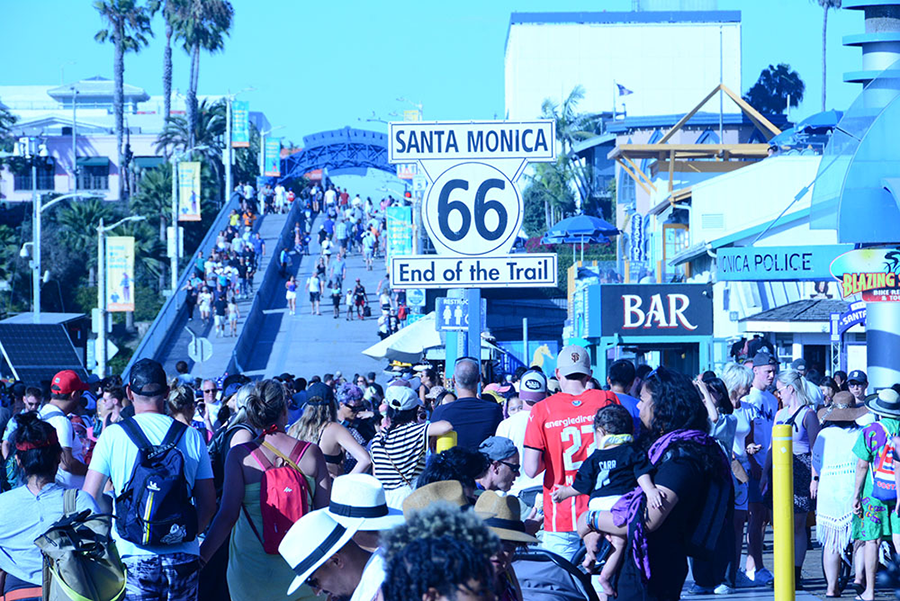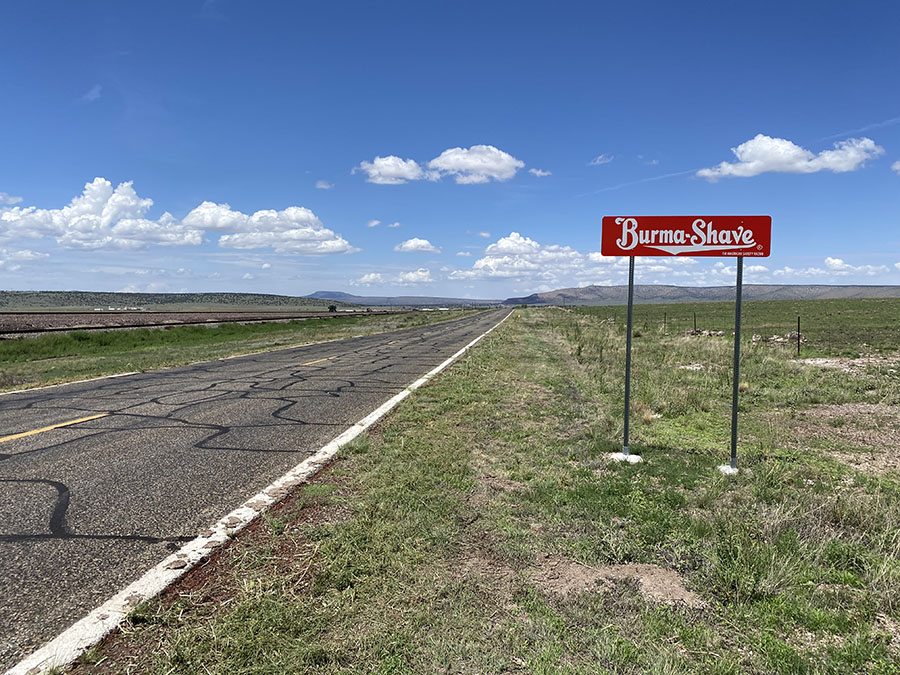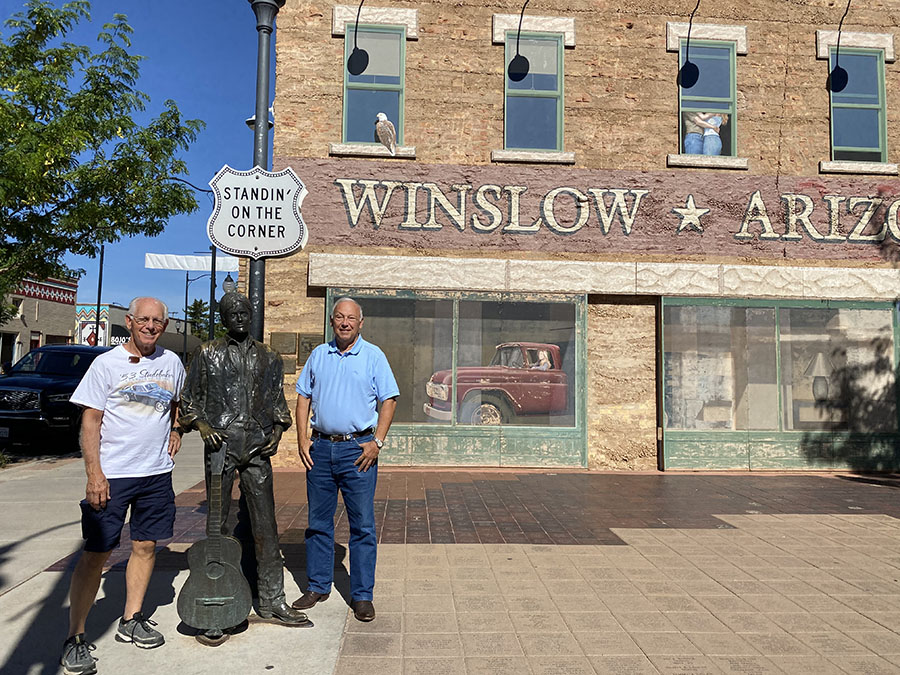Traveling Route 66: Part Two
Submitted by Phil Meek, Austin, Texas

“The West is not a place,……It is a state of mind.”
(Tom Mix, a very popular cowboy star of the silent movie era.)
I love the American West! Anyone who has traveled by highway through the vast expanses of our western states has surely marveled at the sheer beauty before them, whether the Rocky Mountains, rolling prairies, desert vistas, the spectacular Grand Canyon, or the Pacific Coast. One of the best ways to experience our beautiful west is to drive Historic Route 66, the “mother road,” from Oklahoma City, Oklahoma, to its terminus at the Santa Monica Pier, California.
In August 2022, my brother, Gary, and I drove from Texas on I-35 North to Oklahoma City, OK, turned left at the intersection with Route 66 and resumed our journey westward to Santa Monica. (See FoMoCo Times, Vol. 45, Number 1, Jan 2022: “Traveling Route 66 - Part 1.”) A few miles west of Oklahoma City is the geographic 98th Meridian West (longitude). For the United States, this line runs north-south from the Canadian border through a point a few miles west of Oklahoma City and thence down to the East Texas Gulf coast.
The significance of that geographical marker is that 80% of the US population lives east of the 98th Meridian West line, and only 20% of the US population lives west of the 98th Meridian West line. One important reason for this wide disparity of population density between east and west is the lack of sufficient water to support large populations, agriculture, transportation, etc., west of the 98th West Meridian. It is, in effect, a climatic barrier.
The effect of this climatic barrier on the terrain was stark on our journey on Route 66 as we compared the “feel” of driving westward from Oklahoma City to the prior drive from Chicago to Oklahoma City the previous year. Driving through the rural midwest from Chicago, the farms, croplands, houses, barns and other structures were close to the roads. The views down the winding Route 66 ahead were limited to a few thousand feet at most. The small towns were relatively close together. And the road signs for Route 66 in its various alignments over the years were frequent and easy to follow. There was a certain intimacy with Route 66 and the landscape as we motored along. Importantly, we were able to drive almost the entire distance to Oklahoma City on Historic Route 66, avoiding travel on the interstate highways except for a few miles.

In contrast, driving west from Oklahoma City the terrain shifted quickly from rolling hills to flat lands and then to barren deserts, canyons and mountains as we traversed the west. The wide open spaces on Route 66 ahead of us were measured in many miles, with ranch houses, mobile homes and other structures isolated far off in the distance away from the highway. Signs identifying old Route 66 were few and far between. We infrequently saw people or cars on Route 66. Towns and cities were often many miles apart. So watch your gas tank level! Our practice traveling through the west was to fill the gas tank when it reached one half full.
Significantly, traveling through the west, large sections of Route 66 are closed or very difficult to drive due to lack of maintenance, broken pavement, inaccessibility, washed out, converted to gravel roads, located on private property, etc. Some sections of Route 66 have a dead end down the road, and you have to backtrack to the interstate. As a result, we traveled on I-40 much more frequently than we did on the drive from Chicago to Oklahoma City. A very good travel guide which is replete with maps depicting many of these challenges in adhering to the original “mother road” is the “EZ66 Route 66 Guide for Travelers”, by Jerry McClanahan. This was our primary “go to” travel book.
One of the most difficult challenges in driving Route 66 is time management since there are so many interesting sights to see, fellow travelers with whom to chat, tourist stops to make, gift and curio shops to spend money, etc. You will not be able to visit all of the interesting sights along Route 66, so be judicious. Visit others as your schedule allows. We planned to cover about 250 miles a day on our way to Santa Monica, but often found ourselves behind the travel curve for the distances we needed to travel each day. Thus, we had to speed down Interstate 40 to catch up with where we needed to be each night. As a result, we missed sights that we planned to visit.
We stopped the first night at the Western Motel, ca. 1946, in Shamrock, Texas. It was a nice, clean, basic hotel with ample parking. We did not spot any classic cars or Route 66 travelers there. One older guy staying at the motel had a well-utilized 1970 Chevy C10 pickup truck. But he lived in the area and was not passing through on Route 66. The manager informed us that she saw Route 66 travelers infrequently, which is a shame because there are several interesting sights to see.
The main Route 66 attraction in Shamrock is directly across the street from the Western Motel . The Conoco Tower Station, ca. 1936, is a beautifully restored Art Deco gas station. At night it is bedecked in red and green neon bulbs shining brightly. Great photo op!! The building also incorporates the newly restored U-Drop-Inn (no rooms available, however) and Cafe, well-known to travelers on Route 66 in the early days. Also, present at the Conoco Tower Station is an old rusty truck parked out back near five Tesla charging stands, which creates an interesting visual juxtaposition of the old and the new way to travel on Route 66.
Cadillac Ranch, located about 10 miles west of Amarillo, Texas, on I-40 is a fun place to visit. It is easily visible from the highway, not only because of the 12 graffiti-painted Cadillacs buried nose first in the flat, barren prairie, but also because of the long line of cars parked on the I-40 access road. Bring your own cans of spray paint and apply your artistic talents to “improve” this bit of true Americana! No admission charge, and there is a well-stocked gift trailer for souvenirs.
A bit further west on Route 66, we arrived at the Midpoint Cafe in Adrian, TX. Go east from Adrian for 1,139 miles and you will reach the eastern terminus point of Route 66 in downtown Chicago. Go west from Adrian and 1,139 miles later you will reach the western end of Route 66 at the Santa Monica Pier. The MidPoint Cafe is a nice place to take a break and enjoy the vittles, especially the delicious pies! Many fellow travelers on Route 66 in the cafe had stopped for a photo op, to have a bite to eat, and to visit with the patrons.
When we reached Albuquerque, NM, I was anxious to find the statue “Madonna of the Trail”, commissioned by the Daughters of the American Revolution (DAR) around 1929 to honor the brave pioneer mothers of the covered wagon days that settled the west. The DAR commissioned 12 of these memorials, which are placed along Route 66, as well as a few of its predecessor highways that brought settlers from the eastern US to the west. After driving around trying unsuccessfully to find the statue according to directions in the travel books, we stopped for directions in a nearby downtown diner, Lindy’s Diner. It has been open continuously since the late 1920s. Sadly, we were informed that the statue had been taken down about seven years previously in the dead of night without any public notice. We were very disappointed. Nevertheless, the breakfast and conversation at Lindy’s, especially about its long history, were excellent!!
Further westward on Route 66, we spent some time in Tucumcari, NM, and stopped at the Palomino Motel, ca. 1953, with its big neon sign. This U-shaped motel is open 24 hours a day for customers. On down Route 66 is the Tee Pee Curios store, ca.1940s, a must-stop for souvenirs. Across Route 66 is the Blue Swallow Motel, ca. 1940, with a vintage early 1950s Buick sitting out front under the big blue and white neon sign. Expect to spend time in Tucumcari, perhaps overnight if possible so you can see the motel neon lights on full display.
If you have ever hankered to spend the night in a wigwam (well, sort of), stop at the Wigwam Motel #6, ca. 1936, in Holbrook, AZ. This is one of the three remaining original Wigwam Motels, and the office and 12 units have been nicely restored. Under the awning at the motel office was what appeared to be a 1953 Ford and a 1956 Ford, plus a Studebaker pickup truck.
Gary loved the Studebaker pickup! He has owned numerous Studebaker's since his college days and is an expert on anything Studebaker. On the other hand, I had a 1953 Ford Customline sedan and a 1956 Ford Mainline sedan in high school and a couple years of college. So I identified with the two Fords on display at the Wigwam Motel. We both enjoyed looking at the multitude of classic cars parked in front of the wigwam units. Truly, a “back to the ‘50s” experience!
A stop and an overnight stay in Winslow, AZ, are a must for travelers on Route 66. First, a note of caution and a public service announcement: As you exit I-40/Route 66 and head into the downtown area, SLOW DOWN and adhere strictly to the posted speed limits, especially the big drop from 35 mph to 15 mph in downtown. In the short time that we were in Winslow, we observed several cars and a motorcyclist stopped by the police, who were issuing traffic tickets.

As big fans of the classic rock Eagles band, we made our pilgrimage to the “Standing on the Corner” park downtown. What a hoot! If you know the lyrics of the song, you will recognize everything around “the corner.” It provides a great photo opportunity, and there are plenty of enthusiastic Eagles fans around to assist you with your photos to commemorate this important event. Numerous tourist shops for souvenirs and restaurants are around the square.
A block from the downtown park in Winslow is the beautifully restored, southwestern style La Posada Hotel, ca. 1928. This hotel, originally a Fred Harvey “railroad hotel,” is quite a gem, and the room rates are quite reasonable! Take a stroll through the hotel and the gardens, browse through the upscale gift shop, and enjoy an excellent meal in the hotel restaurant. Gary and I really enjoyed our overnight stay there. Highly recommended!
As you reach Flagstaff, consider taking a (long) side trip to the North Rim of the Grand Canyon. Gary and I had visited the South Rim, which is close to Route 66, numerous times. But since I had never visited the North Rim, we turned north on Hwy 89. Although it is only 10 miles as the crow flies between the north rim and the south rim of the Grand Canyon, the drive is around 5 hours, 220 miles, on the circuitous route to the Grand Canyon Lodge on the North Rim. However, the driving time flew by as the scenery was enchanting.
Once we reached the Grand Canyon Lodge at the North Rim, we checked into our modernized small cabin in the woods, one of over 100 cabins which had been built in 1920s-1930s to house the construction workers. This side trip is well worth your time. You will be rewarded for your efforts with much smaller numbers of people than at the South Rim. Note that the North Rim Lodge and room accommodations are only available from May into October. The North Rim National Park and local highways are closed during the winter.
Ashfork, AZ, is an interesting little town that is reminiscent of the ‘50s-‘60s, with several old motels, gas stations, and eateries. Of particular interest is an old gas station with a beautiful 1960 DeSoto hardtop hanging precariously at the edge of the station’s flat roof. While passing through town, we noticed two young girls grazing their goats with leashes attached. Haven’t seen that before!
As you drive south past Kingman, AZ, you will have the option to continue on Route 66 to Oatman, CA, or take I-40 and rejoin Route 66 down the road at Topock. Many travelers stay on I-40 due to concerns about traversing the switchbacks on the narrow road through the mountains ahead. However, the switchbacks are less that 18 miles in length and not difficult to handle, unless you are driving a big RV or pulling a long trailer. Plus, you will get to see the famous wild burros that control the town, the streets, the sidewalks and highways around Oatman! Have you ever seen a burro strolling inside a store? Oatman is a quirky little town, but loads of fun.
Our last night on Route 66 was spent in Barstow, CA. The next morning we had breakfast at a Roy’s Cafe, but it is 75 miles west of the more famous Roy’s Cafe in Amboy. The two Roy’s Cafe’s are owned by the same family. This was going to be a long day of driving as we had to reach the Santa Monica Pier by late afternoon, and we were behind the time curve. So we only made a few stops this day, primarily because more than six hours was spent driving from San Bernardino to Santa Monica on Foothill Blvd/Route 66, with a gazillion stoplights and heavy traffic along the way. The good news is that Foothill Blvd has many old restaurants, gas stations, motels, etc., that have survived , or at least not demolished, from the early days of Route 66. In San Bernardino, look for the second original and restored Wigwam Motel if you missed the one in Holbrook, AZ.
A great stroke of luck occurred when we reached Upland, CA, on Foothill Blvd/Route 66. I happened to look up from my navigating chores and was very surprised to see another of the 12 “Madonna of the Trail” statues. Its location is not mentioned in any of the Route 66 travel books that I have. We stopped to view the 18 foot tall statue and surrounding flower gardens for a while. My disappointment at missing the Madonna statue in Albuquerque abated. Mission happily accomplished!
After getting lost in the maze of streets around the Santa Anita Racetrack for about an hour trying to stay on Route 66, other confusing road signs, heavy traffic, crazy drivers, etc, we managed to work our way to Interstate 10 West, which ended near the Santa Monica Pier. What a sight to see after completing our sojourn from Chicago to Santa Monica, a distance of nearly 2,400 miles, plus our side trips to the North Rim of the Grand Canyon and to Sedona, AZ. After taking the obligatory photographs to document our arrival at each of the two “End of the Trail” locations, we had dinner on the pier and then headed off to Long Beach to visit with Gary’s daughter and family.
I have traveled in each of the 50 states of this great country. But this was my favorite journey of all. Gary and I have many wonderful memories of this trip, and especially of the time traveling together. Everyone should take a trip the full length of Route 66. You won’t regret it!
FINAL NOTE: THE coolest thing that happened on the trip occurred early one morning while driving across western New Mexico. I was listening to a tune playing on the radio when I suddenly realized that the song was Bobby Troup’s “(Get Your Kicks on) Route 66.” Playing was the original recording of the song performed by Nat King Cole in 1946!! You just can’t top that on a trip on ROUTE 66!!








